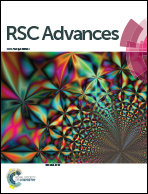Two-way shape memory property and its structural origin of cross-linked poly(ε-caprolactone)†
Abstract
In this work, two-way shape memory (TWSM) properties and the corresponding structural origin of cross-linked poly(ε-caprolactone) (cPCL) with different gel contents obtained by adopting different weight percentages of benzoyl peroxide (BPO) were investigated. The effects of gel contents on melting temperatures, crystallization temperatures and crystallinity of the cPCL materials were studied with differential scanning calorimetry. The TWSM properties of the samples were determined by dynamic mechanical analysis. It was found that gel content was the key factor determining the TWSM behavior, and higher gel content would result in the so-called robust TWSM effect for cPCL samples (cPCLx, x denoting the weight percentage of BPO). Compared with cPCL10, cPCL5 had larger elongation and lower recovery capabilities due to its lower gel content. However, the sample with much lower gel content (cPCL3) displayed almost no TWSM behavior, implying that an appropriate gel content was responsible for the TWSM characteristic. The crystalline structure of cPCLx subsequently changed when subjected to external stress. As the samples were cooled down under constant stress, higher stress would lead to a more oriented crystalline structure. Furthermore, concurrent wide-angle and small-angle X-ray scattering investigations revealed the structural evolution occurring during the TWSM process, indicating that the crystal orientation along the stretching direction took place simultaneously with the elongation during the cooling process.


 Please wait while we load your content...
Please wait while we load your content...